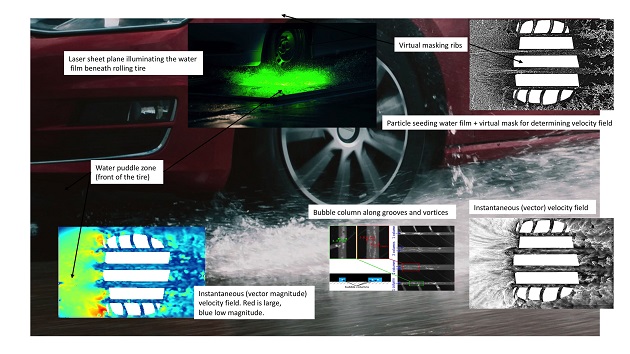When a vehicle travels over a wet or flooded road, water builds up in front of the tire and generates a lift force. In a phenomenon known as Hydroplaning, this force can become large enough to lift the vehicle off the ground.
In Physics of Fluids, scientists from the CNRS, the University of Lyon, and The Michelin Group use a laser imaging technique to study water flow in front of and through tire grooves.
To counteract hydroplaning, tread designs are chosen to drain water from the front of the tire without decreasing its ability to adhere to the road. Very few quantitative experimental studies of the movement of water through tire grooves have been done, so little is known about the exact flow patterns in these situations.
The only previously published work reporting quantitative velocity measurements in tire grooves was done with a high-speed camera and used millet seeds as water tracers. The seeds are about 1.5 millimeters in diameter, though, and provide poor contrast, so velocity information inside the grooves was not usable for a flow analysis.
Currently, research into hydroplaning uses a test track equipped with a transparent window embedded in the ground. The area above is flooded and a tire rolling over the window is observed with a high-speed camera.
The investigators developed a more sophisticated approach involving fluorescent seeding particles to visualize the flow and used a sheet of laser light to illuminate the area. The fluorescent particles were only 35 microns in diameter, about half the thickness of a human hair, with a density close to water.
“The first remarkable feature of the flow inside grooves is the presence of white elongated filaments or columns,” said author Damien Cabut. “This indicates the presence of a gaseous phase, possibly air bubbles or cavitation.”
There are two phases in the grooves, liquid and gas, which complicates the analysis. The investigators found vortices and bubbles in some grooves. The authors showed the number of vortices inside a groove is related to the ratio of the groove’s width to its height.
“One vortex creation mechanism could be linked to the flow around the sharp edge of the tire rib. This effect is similar to one observed for delta wings in aerodynamic lift,” said Cabut.
The flow structure in the grooves was found to be similar for increasing vehicle speeds when distances and velocities were properly scaled up. This could have implications for hydroplaning.
Cabut said more work needs to be done to understand the formation of vortices and the role of bubbles in the grooves. The experimental setup they developed will be a great help with that future work.








